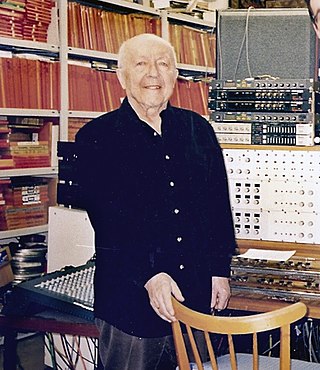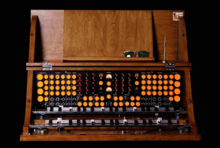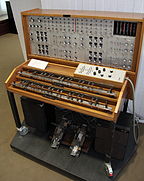
An analog synthesizer is a synthesizer that uses analog circuits and analog signals to generate sound electronically.

The Electro-Theremin is an electronic musical instrument developed by trombonist Paul Tanner and amateur inventor Bob Whitsell in the late 1950s to produce a sound to mimic that of the theremin. The instrument features a tone and portamento similar to that of the theremin, but with a different control mechanism. It consisted of a sine wave generator with a knob that controlled the pitch, placed inside a wooden box. The pitch knob was attached to a slider on the outside of the box with some string. The player would move the slider, thus turning the knob to the desired frequency, with the help of markings drawn on the box. This contrasts with the theremin, which a performer plays without touching as two antennas sense the position and movement of the performer's hands.

Modular synthesizers are synthesizers composed of separate modules for different functions. The modules can be connected together by the user to create a patch. The outputs from the modules may include audio signals, analog control voltages, or digital signals for logic or timing conditions. Typical modules are voltage-controlled oscillators, voltage-controlled filters, voltage-controlled amplifiers and envelope generators.

In electronics, ring modulation is a signal processing function, an implementation of frequency mixing, in which two signals are combined to yield an output signal. One signal, called the carrier, is typically a sine wave or another simple waveform; the other signal is typically more complicated and is called the input or the modulator signal. A ring modulator is an electronic device for ring modulation. A ring modulator may be used in music synthesizers and as an effects unit.

Buchla Electronic Musical Instruments (BEMI) was a manufacturer of synthesizers and unique MIDI controllers. The origins of the company could be found in Buchla & Associates, created in 1963 by synthesizer pioneer Don Buchla of Berkeley, California. In 2012 the original company led by Don Buchla was acquired by a group of Australian investors trading as Audio Supermarket Pty. Ltd. The company was renamed Buchla Electronic Musical Instruments as part of the acquisition. In 2018 the assets of BEMI were acquired by a new entity, Buchla U.S.A., and the company continues under new ownership.
Doepfer Musikelektronik GmbH is a German manufacturer of audio hardware, mostly synthesizer modules, based in Gräfelfing, Upper Bavaria and founded by Dieter Döpfer. The product range covers analog modular systems, MIDI controllers, MIDI hardware sequencers, MIDI-to-CV/Gate/Sync Interfaces, MIDI master keyboards and special MIDI equipment.

Oskar Sala was a German composer and a pioneer of electronic music. He played an instrument called the Trautonium, an early form of electronic synthesizer.

The Moog synthesizer is a modular synthesizer invented by the American engineer Robert Moog in 1964. Moog's company, R. A. Moog Co., produced numerous models from 1965 to 1981, and again from 2014. It was the first commercial synthesizer and established the analog synthesizer concept.
Polyphony is a property of musical instruments that means that they can play multiple independent melody lines simultaneously. Instruments featuring polyphony are said to be polyphonic. Instruments that are not capable of polyphony are monophonic or paraphonic.

The Doepfer A-100 is an analog modular synthesizer system introduced by German audio manufacturer Doepfer in 1995. Although there were only 10 module types at time of release, it currently has more than 120 modules plus several different enclosures and accessories.
Harald Genzmer was a German composer of classical music and an academic.

The Subharchord is a synthesizer featuring subharmonic synthesis. It was developed in the mid-20th century by technicians in the German Democratic Republic.
In music, the undertone series or subharmonic series is a sequence of notes that results from inverting the intervals of the overtone series. While overtones naturally occur with the physical production of music on instruments, undertones must be produced in unusual ways. While the overtone series is based upon arithmetic multiplication of frequencies, resulting in a harmonic series, the undertone series is based on arithmetic division.

A synthesizer is an electronic musical instrument that generates audio signals. Synthesizers typically create sounds by generating waveforms through methods including subtractive synthesis, additive synthesis and frequency modulation synthesis. These sounds may be altered by components such as filters, which cut or boost frequencies; envelopes, which control articulation, or how notes begin and end; and low-frequency oscillators, which modulate parameters such as pitch, volume, or filter characteristics affecting timbre. Synthesizers are typically played with keyboards or controlled by sequencers, software or other instruments and may be synchronized to other equipment via MIDI.

Harald Bode was a German engineer and pioneer in the development of electronic musical instruments.

The AX80 is a polyphonic analogue keyboard synthesizer manufactured by Akai Professional in 1984. It was Akai's first venture into the professional electronic musical instrument market. The AX80 used digitally controlled oscillators (DCO) and filter circuitry based on the Curtis Electronics CEM 3372 integrated circuit. It was marketed as part of a line of project studio equipment called the Akai Music Studio System, which included the S612 digital sampler the MR16 drum machine, the MS08 sequencer, and the MG1212 multitrack tape recorder, at a price of $1,695 US.
The Swarmatron is an analogue synthesizer developed by Dewanatron, consisting of cousins Brian and Leon Dewan. Hand-made by the Dewans, it has eight oscillators controlled by a single ribbon controller. The oscillators are linked through a 'swarm' control, giving it a distinctive sound that flows in and out of unison, comparable to the noise a swarm of bees produces.
In sound and music, an envelope describes how a sound changes over time. For example, a piano key, when struck and held, creates a near-immediate initial sound which gradually decreases in volume to zero. An envelope may relate to elements such as amplitude (volume), frequency or pitch.

Eurorack is a modular synthesizer format originally specified in 1995 by Doepfer Musikelektronik. It has since grown in popularity, and as of 2022 has become a dominant hardware modular synthesizer format, with over 15,000 modules available from more than 1000 different manufacturers ranging from DIY kits and boutique, cottage-industry designers to well-known, established synth mass-manufacturers like Moog and Roland.
Friedrich Trautwein was a German engineer. Trautwein developed the Trautonium and is considered a pioneer of electronic music in Germany.

















